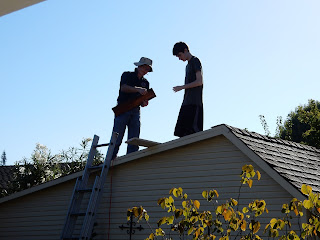Service to Others
Young people serve in the community one hour or more per week.
This document is designed to help adults throughout Santa Clara County develop materials and activities to promote the asset of adult role models.
Newsletter Content
The following text may be used in organizational newsletters. Please include the attribution at the end of the article.
The Importance of Service to Others
Community service, volunteering, and service learning do more than allow youth to help the community these activities also provide youth
with the positive experiences, relationships, and connections that help them thrive. Research shows that the developmental asset of service to others results in higher academic performance, increased self-esteem, reduced incidence of depression, better problem-solving skills, and increased community
involvement as an adult.
Unfortunately, most youth in Santa Clara County don’t participate in significant service to others. In Project Cornerstone’s 2011 survey, 32% of 4th-6th graders and only 47% of 7th-12th graders reported that they serve in
the community one or more hours each week.
To help raise awareness of the importance of this developmental asset,
April is Service to Others month in Silicon Valley.
One reason that youth may not serve is the perception that their assistance
isn’t welcomed—a Gallup poll found that adolescents were four times more likely to volunteer and help out in the community if they were asked, but only half of a national sample of youth reported that adults asked them to help out. Youth gain the greatest benefit from service programs that enable them to “do” instead of observe; to work with supportive adults; to demonstrate responsibility, to explore their own interests and ideas, and to reflect on the meaning of their activities.
The following discussion topics can help young people recognize the value of service to others and identify new kinds of service opportunities:
• Ask a young person to complete this sentence:
“One way I’d like to change the world is…”
• What are some needs or problems that you see and are concerned about in the community? What do you think can solve these issues? What can you do to get the ball rolling?
• If you had to commit one year after high school to performing service in your own community, elsewhere in the United States, or abroad, where would you go and what would you choose to do?
This article was provided courtesy of Project Cornerstone’s Asset-a-Month program.
Activities
For families
• At mealtime, share your recent community service activities with your family. This discussion demonstrates that your family values service,
enables you to role-model community service, and opens a discussion about ways to help in the community.
• Serving others doesn’t always mean taking on a big commitment—it can be as simple as picking up litter in the park, helping an elderly neighbor unload their groceries, or bringing a meal to a sick neighbor.
• Have a family meeting to consider the idea of a family service project, and make sure that everyone participates regardless of their age. Have everyone list their volunteer activities to see if others are interested in helping, and talk about additional causes that each member would like to support.
For all adults
• Create youth-oriented volunteer opportunities that are diverse in
the amount of time, energy, and expertise required. To make sure that youth get the most out of the experience, provide adequate training and make sure that the youth understand how their efforts will make a difference.
• When seeking volunteers, don’t just reach out to the high-achieving youth in leadership programs! Young people from all backgrounds deserve the opportunity to experience the benefits of service.
• Be sure to affirm and recognize the efforts of all the youth who serve.
At school or in youth programs
• Service learning programs that link educational or program objectives with opportunities to address real-world issues are a proven strategy for increasing developmental assets. Resources to help get started with service learning programs can be found in the “Resources” section below.
• Start a service club for youth! Work with the group to identify a list of causes that they care about (e.g., animals, education, environment,
creating safe places for youth to hang out, health care, disaster relief,
homelessness, peace, etc.) and identify ways that they can help.
Help the youth research the need, define goals, create a plan
(being sure to consider the potential needs and feelings of the recipients), and implement their service ideas. Be sure to guide the youth in reflecting on their experience at the end of the project.
• You can also create service opportunities for youth within the school or program itself. Work as a group to list needs that youth have observed at the site, like picking up litter or refereeing games for younger children, and ask youth to choose which needs they’d like to address. If their choices require the permission of other staff members, have the youth choose a team of
representatives to present their offer to the person in charge, and coach
them on how to make their presentation.
Additional Resources
• The Volunteer Center of Silicon Valley’s Santa Clara County Youth Volunteer Guide provides a comprehensive list of service
opportunities for youth 12-17, arranged by areas of interest and
kind of service available. The guide includes coaching for youth
on what to say when they call an agency for information or visit the
site for a volunteer interview.
• A wealth of information about service learning is available at Search Institute’s “Service Learning and Asset Building” Web page at http://www.searchinstitute.org/content/service-learning-and-asset-building.
Resources include a free guide to service learning in community-based organizations as well as fact sheets, resources, and links to information from national service learning organizations.
About the Asset-a-Month Program
The goals of the Silicon Valley Asset-a-Month program are to help align adults throughout our diverse community in their efforts to promote positive youth development by fostering developmental assets. For more information about the
Asset-a-Month program, contact Project Cornerstone at
Reverend Felecia Mulvany, D.D.
President, Sacred Foundations, Inc.
revmulvany@sacredfoundations.net
www.sacredfoundations.net
877-877-4275









